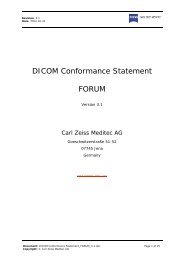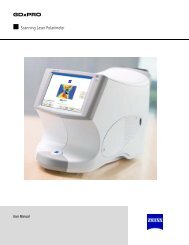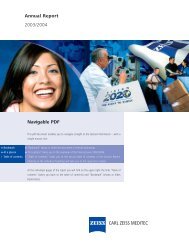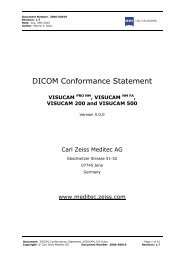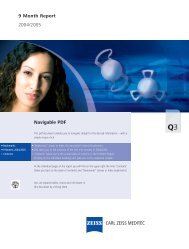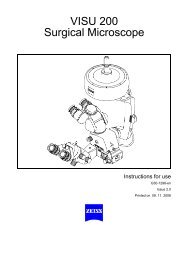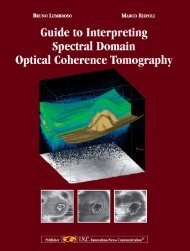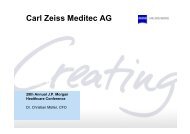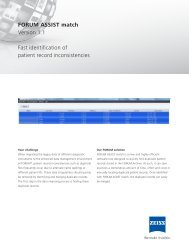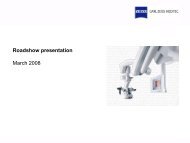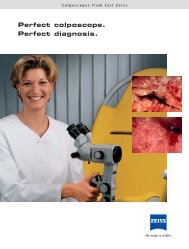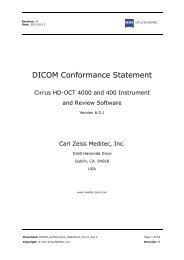Download - Carl Zeiss Meditec AG
Download - Carl Zeiss Meditec AG
Download - Carl Zeiss Meditec AG
Create successful ePaper yourself
Turn your PDF publications into a flip-book with our unique Google optimized e-Paper software.
ReLEx smile: Flapless. All-femto. Single-step.<br />
Biomechanical Advantages<br />
of ReLEx smile<br />
Compared to LASIK, this flapless refractive surgery technique maintains a stress pattern<br />
that more closely resembles the unoperated cornea.<br />
BY CYNTHIA J. ROBERTS, PhD; ABHIJIT SINHA ROY, PhD; WILLIAM J. DUPPS, MD, PhD;<br />
AND JESPER HJORTDAL, MD, PhD<br />
For more than 1 year now, surgeons have been using<br />
ReLEx smile to provide patients with refractive correction<br />
via lenticule extraction. Although there are<br />
numerous potential benefits compared with LASIK, this<br />
article will focus on the biomechanical advantages of the<br />
ReLEx smile cap as compared with the LASIK flap.<br />
ReLEx is exclusively performed with the VisuMax<br />
femtosecond laser (<strong>Carl</strong> <strong>Zeiss</strong> <strong>Meditec</strong>). This minimally<br />
invasive procedure uses tissue removal with two femtosecond<br />
incisions that intersect to create a lenticule for<br />
extraction, in place of tissue ablation, which is the mechanism<br />
of action for LASIK and PRK corrections. From<br />
results thus far, several surgeons have shown that ReLEx<br />
smile introduces very little spherical aberration across<br />
the optical zone and increases treatment efficiency, especially<br />
for higher refractive errors, because only two incisions<br />
are needed to create a lenticule independent of the<br />
level of correction and only one laser is used.<br />
Dr. Hjortdal has been using ReLEx smile for 18 months.<br />
He has also seen similar trends, and his patients have<br />
been happy with their postoperative outcomes.<br />
However, the scientist side of him wanted to know<br />
Figure 1. Meshing was performed in Truegrid with 8-noded, linear, hexahedral<br />
elements.<br />
4 SUPPLEMENT TO CATARACT & REFRACTIVE SURGERY TODAY EUROPE OCTOBER 2012<br />
The ReLEx smile cap created<br />
less of a defect in the anterior<br />
surface [compared with LASIK],<br />
and thus had a central surface<br />
stress that was closer to the<br />
preoperative state.<br />
more, which led to a collaboration with Drs. Roberts,<br />
Dupps, and Sinha Roy for biomechanical modeling.<br />
Specifically, could this procedure provide higher biomechanical<br />
stability compared with traditional LASIK<br />
as well as femtosecond LASIK?<br />
THE ReLEx smile CAP<br />
With ReLEx smile, there is no longer a need to create a<br />
corneal flap. Instead, a small side cut incision is created at<br />
an approximate depth of 100 to 120 µm in the cornea for<br />
lenticule extraction, creating a smile cap. The obvious benefits<br />
of cap creation are that (1) complications associated<br />
with the LASIK flap cut, including<br />
incomplete and irregular flap cuts,<br />
thin flaps, buttonholes, and free<br />
caps, are eliminated and (2) reduced<br />
risk of induced astigmatism related<br />
to flap complications.<br />
We hypothesize, however, that<br />
there are additional biomechanical<br />
advantages to ReLEx cap creation<br />
over a flap. Therefore, we recently<br />
designed a nonlinear, anisotropic,<br />
fiber-dependent material model<br />
to compare the biomechanical<br />
consequences of ReLEx smile to a<br />
standard LASIK procedure.<br />
To create this model, we used



